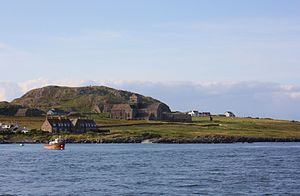Iona (Scotland)
| Iona (Ì Chaluim Chille) | |
|---|---|
| The abbey seen from the sea | |
| Waters | North Atlantic |
| Archipelago | Inner Hebrides |
| Geographical location | 56 ° 19 ′ 48 ″ N , 6 ° 24 ′ 0 ″ W |
| surface | 8.8 km² |
| Highest elevation | Dùn Ì 101 m above sea level NN |
| Residents | 125 (2011) 14 inhabitants / km² |
| main place | Baile Mòr |
|
Map from 1874, with structure: * Ceann Tsear * Sliabh Meanach * Machar * Sliginach * Sliabh Siar * Staonaig |
|
Iona ( Scottish Gaelic : Ì Chaluim Chille , formerly also Ì , also Anglicised Icolmkill and Hy ) is an island in the Inner Hebrides in Scotland . Iona was the spiritual center of Scotland for centuries.
geography
Iona is about 1.6 kilometers west of the island of Mull and is 8.8 km² in size. The highest point is the 101 meter high Dùn Ì . In 2011, 125 people lived on the island, most of them in the main town of Baile Mòr.
The island belongs to the Civil Parish Kilfinichen & Kilviceuen , the main part of which occupies the southwest of the island of Mull, and forms the Icolmkill district therein .
The following territorial structure is drawn on a map from 1874 (from north to south):
- Ceann Tsear
- Sliabh Meanach
- Machar
- Sliginach
- Sliabh Siar
- Staonaig
history
The settlement of the island of Iona can be traced back to the Stone and Bronze Ages. The oldest surviving historical evidence is the small 3,000 year old burial mound Blàr Buidhe, next to Baile Mòr. There is an Iron Age ring wall on Dùn Bhuirg on the west side of the island. The hill Dùn I near the abbey has no traces of fortification. Whether Dùn Bhuirg was still occupied when Columban came is unknown, but it is unlikely that he found the island empty.
In 563 Columban and twelve men came from Ireland to Iona and founded the monastery Iona Abbey there . From Iona, Christianity spread in the form of the so-called Celtic Church in Scotland and northern England . The Book of Kells , one of the most valuable works of island book illumination , was probably written on Iona in the 7th or 8th century. Iona was the spiritual center of the Celtic Church, whose followers were the Culdeer .
Iona was considered a "holy place" for several centuries. Scottish-Irish and Norwegian kings are said to be buried in the Reilig Odhráin cemetery. Iona was the burial place of the kings of Dalriada and their successors, the early kings of Scotland . The last of these was Macbeth, known from Shakespeare 's drama of the same name . Numerous crosses were made on Iona at this time. Many were later thrown into the sea by Puritan groups. The St. John's Cross from the 8th and St. Martin's Cross from the 9th century still exist, as well as some fragments.
The Celtic monastery complex existed until the 11th century. It was destroyed by Viking raids (795, 802, 806). In the 12th century, the Culdeer were subject to the northward pushing supporters of the Roman Catholic Church . As a result, a second monastery in 1203 arose as a Benedictine - Abbey and Cathedral of the islands. The monastery existed until the Reformation , then fell into disrepair and was rebuilt from 1939.
In the 19th century, green marble was mined on Iona . The quarry is still there today. Theodor Fontane visited the island in 1858. He described the island and its history in his book Beyond the Tweed .
In 1938 George MacLeod (later Rt. Rev. Lord MacLeod of Fuinary ), pastor of the Church of Scotland in Govan ( Glasgow ), founded the Iona Community on Iona , a Christian community that emphasizes mission and social work. The aim of the work of this community is to “find new ways to reach the hearts of all”. The community does this primarily through youth work, new songs, worship services and divine service modules as well as commitment to justice and peace. Their activities included rebuilding the abbey.
The former leader of the Labor Party , John Smith (1938-1994), was buried with special permission on Reilig Odhráin .
traffic
From Fionnphort on Mull, a ferry takes around ten minutes to Iona. Only locals are allowed to use vehicles on Iona.
Others
Iona was one of the favorite landscapes of the Scottish painter Francis Cadell , who played a central role in his landscapes after 1912.
A Scottish progressive rock band is called Iona . In their music, they refer to the island and its past, including in a concept album about the Book of Kells.
The Scottish composer James MacMillan composed the work Í for strings and percussion as variations on Iona in 1996 .
gallery
Ruins of the Iona nunnery
Web links
- 360 ° aerial panorama of Iona
- The Isle of Iona (English)
- The Iona Community (English)
- Theodor Fontane : Beyond the Tweed in the Gutenberg-DE project
Individual evidence
- ↑ 2011 Census: First Results on Population and Household Estimates for Scotland - Release 1C (Part Two) , p. 11. National Records of Scotland, August 15, 2013, accessed on September 19, 2017 (pdf; 96 kB; English).
- ^ Ordnance Survey County Map Sheet Iona (1899)
- ^ The New Statistical Account of Scotland, 1845
- ↑ John Bartholomew: Modern Hy (1874)
- ^ Archaeologist links Iona to the Bronze Age. In: The Oban Times . April 24, 2009, archived from the original on May 1, 2009 ; accessed on September 19, 2017 (English).








